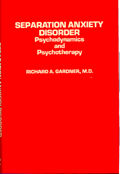|

|
Separation Anxiety Disorder Specific Techniques and Verbatim Clinical Vignettes |
|
HIGHLIGHTS
|
|
The separation anxiety disorder is one of the more common psychiatric problems of children. Statistics on its incidence and prevalence are difficult to obtain because its milder forms are not commonly brought to the attention of mental health professionals. However, when seen in its full-blown form, it is relatively easy to diagnose. There are few diagnoses in all of psychiatry in which there would be greater inter-rater reliability than the separation anxiety disorder. Not only does the purity of the disorder contribute to the ease with which it is diagnosed, but the psychodynamic processes that are often contributory also have a uniformity and consistency that is unusual in psychiatric disturbances. All psychogenic disorders are multidetermined, but there is great variation among individuals with regard to the specific psychodynamic factors that contribute. Although there are certainly individual differences with regard to these contributing factors, most examiners agree that in the separation anxiety disorder there is far less variability in the clinical picture, family contributions, and psychodynamic patterns than is to be found in other forms of psychopathology. The book begins with a detailed description of the typical clinical picture, in both the child and the family. The author then provides an in-depth discussion of the underlying psychodynamic factors, including his own contributions in this area. Next he discusses the theoretical principles that can serve as the foundation for treatment for these children. Material is then presented which describes exactly how Dr. Gardner applied these principles to the treatment. Clinical vignettes complement the text and these enable the therapist to learn precisely what the author did in his sessions with these children. A final chapter is devoted to the termination phase of treatment. This is a unique book with regard to the scope and depth with which it deals with this clinical entity. It is practical, eminently useful, and should prove of value to all therapists who treat these children. |
